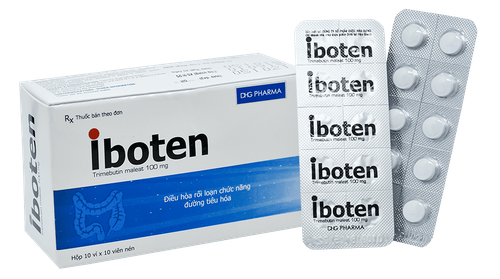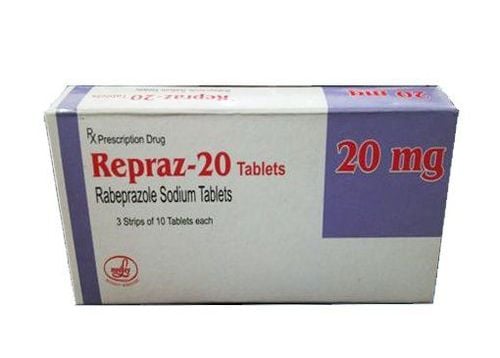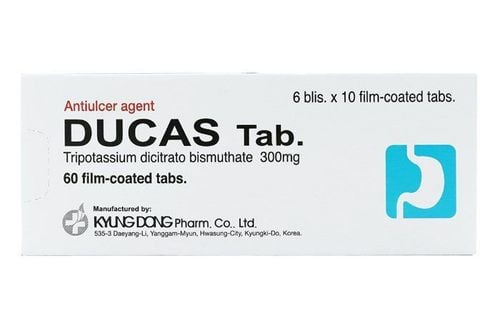This is an automatically translated article.
Posted by Doctor Mai Vien Phuong, Department of Examination & Internal Medicine - Vinmec Central Park International General HospitalDouble oesophagitis is a rare congenital malformation of the esophagus, ranking second in the gastrointestinal tract after ileal duplication and accounting for about 15% of all congenital malformations of the esophagus. The disease is divided into 2 types: cystic double esophagus being the most common form (95%) and tubular double esophagus being very rare.
1. Double esophageal cyst
The vast majority of cases of double esophagus are detected in the fetal period by fetal ultrasound and in the first years of life because of the disorders it causes, which are very rare in adulthood. Depending on the location and size of the double esophagus, it causes different symptoms, the most common are digestive disorders such as: pain behind the sternum, choking, vomiting... or respiratory disorders. , circulation such as shortness of breath, arrhythmia... However, there are cases where the disease is diagnosed incidentally. Some tests such as esophagography with barite contrast, computed tomography of the esophagus or endoscopic ultrasound of the esophagus help diagnose the disease before surgery, but to confirm the diagnosis, it is necessary to rely on anatomical tests. sick.
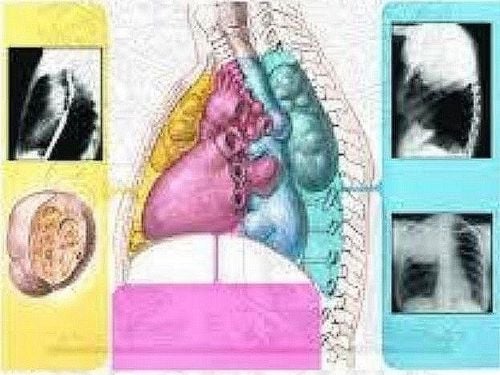
2. Overview of the double digestive tract
Digestive tract double, or gastrointestinal double cyst, is a rare congenital malformation of the gastrointestinal tract. The etiology of gastrointestinal double cysts is not fully understood; however, an early developmental abnormality during the embryonic stage of gastric formation is thought to be the most likely cause. Based on autopsy reports, it is estimated that gastrointestinal double cysts affect 1 in every 4,500 patients. It mainly occurs during childhood, has a highly variable clinical presentation, depending on its location and size. Exploratory imaging studies can help identify double cysts in some cases; however, these cannot distinguish its pathology from Meckel's diverticulum or other gastrointestinal cyst-like diseases. Therefore, the definitive diagnosis of gastrointestinal double cyst remains a challenge for clinicians.
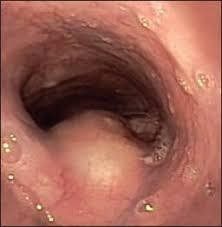
3. Is the double gastrointestinal tract common?
Digestive tract duplication mainly occurs in the ileum of the small intestine, accounting for over 40% of cases. Esophageal double cysts are much rarer, accounting for 4% of all cases and 10-15% of all gastrointestinal double cysts. Gastrointestinal duplication (abbreviated as Double Esophageal Cyst) was originally characterized by Blasius in 1711 and was formerly classified as a type of esophageal cyst, due to duplication of the submucosa and muscle of the esophagus. Esophageal double cysts may communicate with the lumen of the esophagus. Esophageal double cysts are also the second most common benign posterior mediastinal lesion in children, after bronchial cysts. The incidence of double gastrointestinal tract is 1 in 8,200, with twice as many males as females. While esophageal cysts mainly occur in the thoracic segment, in addition, esophageal cysts can occur in the cervical esophagus and abdominal esophagus.
4. Mechanism of formation of double gastrointestinal pathology
The pathogenic mechanisms of esophageal double cyst are unknown; however, it is thought to be related to the abnormal development of the esophagus that occurs in the fifth to eighth week of pregnancy, when the anterior primordial posterior portion unites to form an esophageal tube only. Esophageal double cysts are relatively common in children with mediastinal mass, accounting for 30% of all mediastinal masses in children.
5. How is the double esophageal cyst structured?
Esophageal duplication cysts - Esophageal double cysts may contain ectopic gastric mucosa and pancreatic contents. The extraesophageal gastrointestinal mucosa is thought to result from the replacement of single columnar epithelium by stratified squamous epithelium during esophageal embryogenesis. This condition is often discovered incidentally by endoscopy or biopsy and manifests in the gastric mucosal entry. Ectopic gastrointestinal mucosa can complicate the symptoms of the indistinguishable gastrointestinal tract, especially those related to the ileum, especially the ectopic GI mucosa which can cause Symptoms are similar to those of Mecke's diverticulum. Patients may present with symptoms of gastrointestinal bleeding, bowel obstruction, diverticulitis, and umbilical abnormalities. However, some studies in the literature have mentioned esophageal double cysts with ectopic gastric mucosa.
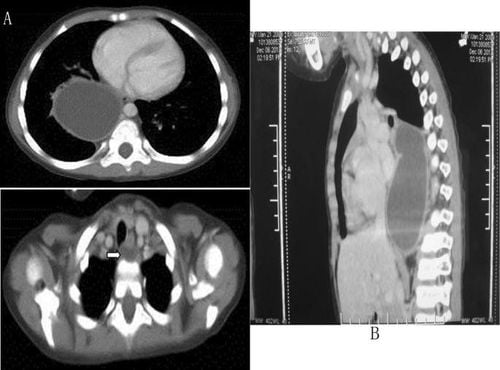
Figure 3: Computed tomography image of a 3-year-old, previously healthy, male patient presenting with intermittent acute fever and dry cough, but not dysphagia, fever (39.0°C) . Computed tomography (Computerized tomography) on initial examination revealed a large mediastinal mass in the thorax, complicated by pneumonia. Three-dimensional computed tomography reconstruction revealed that the two oval cysts were located in the posterior mediastinum, clearly demarcated, and filled with fluid, but without any air-fluid levels. The larger cyst measures 10 cm x 5.4 cm x 5.8 cm. It is located in the middle and lower part of the esophagus in the paravertebral space and extends along the right vertebral groove. The cyst displaced the trachea anteriorly, the right main bronchus, and the right lower lobe of the lung anteriorly. The smaller cyst was located in the middle of the posterior wall of the cervical esophagus, measuring 1.0 cm × 0.8 cm. Computed tomography Contrast scan did not show any obvious enhancement of both cysts. The patient was diagnosed with a diagnosis of esophageal cyst with complications of bronchopneumonia.
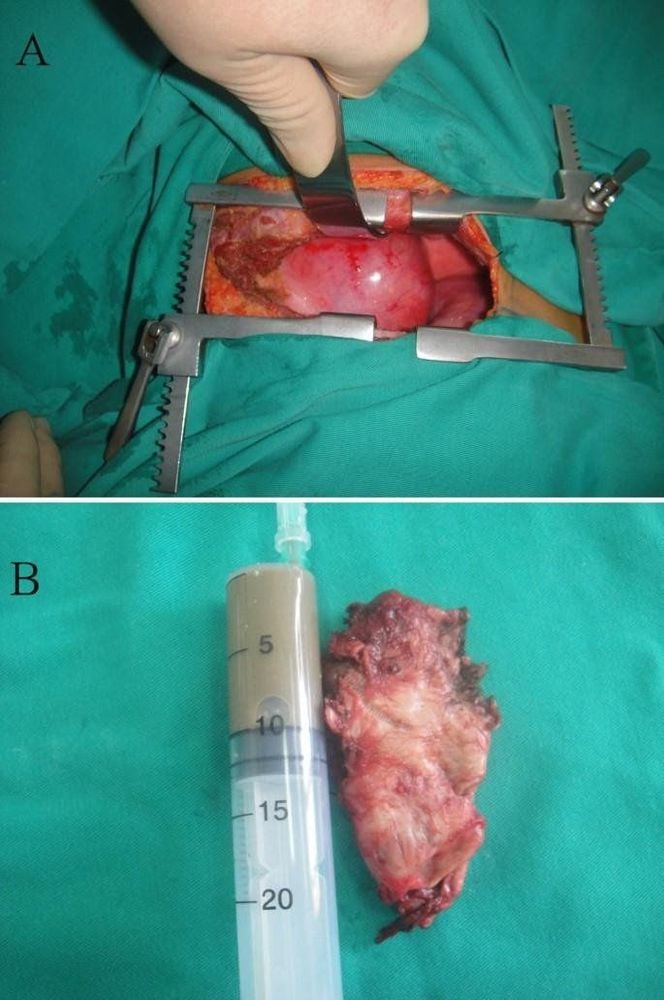
Figure 4: Intraoperative image of large esophageal double cyst in the above patient. (A) A cystic mass is located in the right posterior mediastinum; and (B) Macroscopic view of the resected cyst containing brown cystic fluid. A double-lumen endotracheal tube was used to deflate the right lung, and a right thoracotomy was performed along the sixth intercostal space. A 10 cm x 5.4 cm x 5.8 cm cyst originating in the right wall of the esophagus at the carina level was identified. The cyst wall is about 0.3 cm thick and moderately adherent to the membranous portion of the right main bronchus and the dorsal segment of the right lower lobe; however, it does not communicate with the esophagus or bronchopulmonary tree. The cyst was punctured and deflated with an 18-gauge needle. Approximately 200 ml of a brown, viscous fluid, suggestive of internal bleeding, was drained.
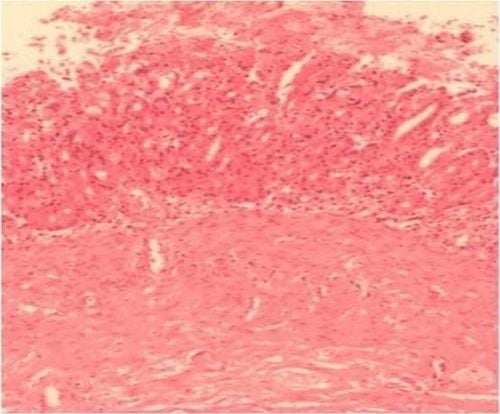
Please dial HOTLINE for more information or register for an appointment HERE. Download MyVinmec app to make appointments faster and to manage your bookings easily.
We invite you to continue reading part 2: Symptoms and treatment of double esophageal cysts
References
Zhefeng Zhang et al., Double esophageal duplication cysts, with ectopic gastric mucosa: a case report. Journal of Cardiothoracic Surgery volume 8, Article number: 221 (2013) Emura T, Hashizume K, Asashima M. Experimental study of the embryogenesis of gastrointestinal duplication and enteric cyst. Pediatr Surg Int. 2003;19:147–151. [PubMed] [Google Scholar] Iyer CP, Mahour GH. Duplications of the alimentary tract in Children and children. J Pediatr Surg. 1995;30:1267–1270. doi: 10.1016/0022-3468(95)90482-4. [PubMed] [CrossRef] [Google Scholar] Kiratli PO, Aksoy T, Bozkurt MF, Orhan D. Detection of ectopic gastric mucosa using 99mTc pertechnetate: a review of the literature. Ann Nucl Med. 2009;23:97–105. doi: 10.1007/s12149-008-0204-6. [PubMed] [CrossRef] [Google Scholar]







